
On a walk in a local park this week, I found myself scanning the trail. From the trunks of trees to the edges of the path, I was looking for signs of the small and scaly residents of my North Florida hometown: snakes. My newfound appreciation for these reptiles is due to a recent read of Saving Snakes: Snakes and the Evolution of a Field Naturalist. In her first book, Dr. Nicolette Cagle takes readers on a personal journey across continents as she advocates for respect for the world's 10,000 snake species. Part memoir, part travelogue, part natural history, it shows us how snakes’ lives are intertwined with our own, and what we can do to protect them now and into the future.
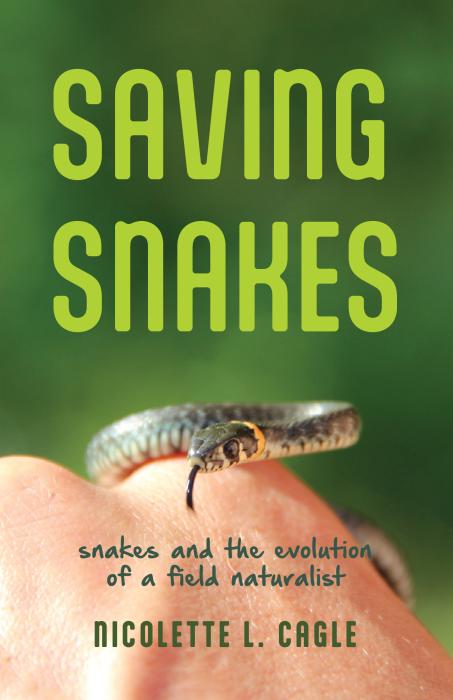
I sat down with Dr. Cagle to learn more about her interest in and perspective on snakes, and how we can all learn more about these amazing reptiles.
Let's start with the most critical question — do you have a favorite species of snake?
Nicolette: I adore eastern fox snakes (Pantherophis vulpinus). To me, these are the quintessential snakes of the tallgrass prairie, roaming across grasslands, oak savannas, and farmlands. They primarily eat rodents, which eat grains and other crops, so farmers have good reason to appreciate them. Fox snakes also seem quite friendly, despite their large size (they can reach up to 6 feet in length). This is probably due, in part, to their rounded faces and mouths that look slightly upturned, as if they’re smiling. Also, they are spotted, and their spots look like delicious squares of dark chocolate.
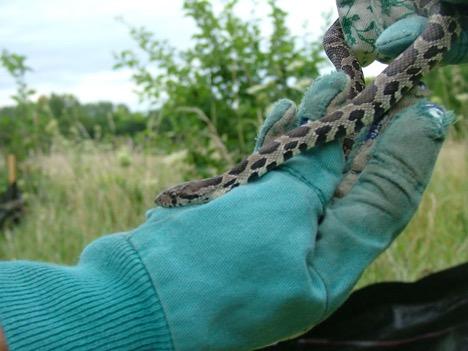
the author’s dissertation research in August 2004. Photo by N. Cagle.
Fox snakes also remind me of home. Some of the first western scientific observations of eastern fox snakes occurred in Wisconsin, just over the border from where I grew up in northern Illinois. The type specimen — the one that western scientists used to describe the species — came from Racine. Also, zoologist James Gillingham first described the eastern fox snake’s courtship behavior in Wisconsin; this was only in the early 1970s. The courtship is lovely and includes the male flicking his tongue up the female’s body, chasing her, and then initiating gentle body contact.
You can recognize so many species of snakes, and you teach others identification skills too. Does recognizing a species and knowing its name change an individual's relationship with that creature?
Nicolette: Absolutely! Recognizing a species allows me to greet an animal by name, to acknowledge it as a respected friend. When we meet someone new, or address someone we admire, we often start the conversation with their name, saying something like, “Erika, it is a pleasure to see you again.” This is our way of showing respect.
The same goes for animals. When we walk up to a snake, and silently say, “Good evening, bullsnake — Pituophis catenifer sayi — it is lovely to see you,” we are acknowledging that the animal has value, that its name is worth knowing and, by noting its scientific name, we’re saying, “I care where you come from, evolutionarily, and about your family, and all the other species to which you’re related.”
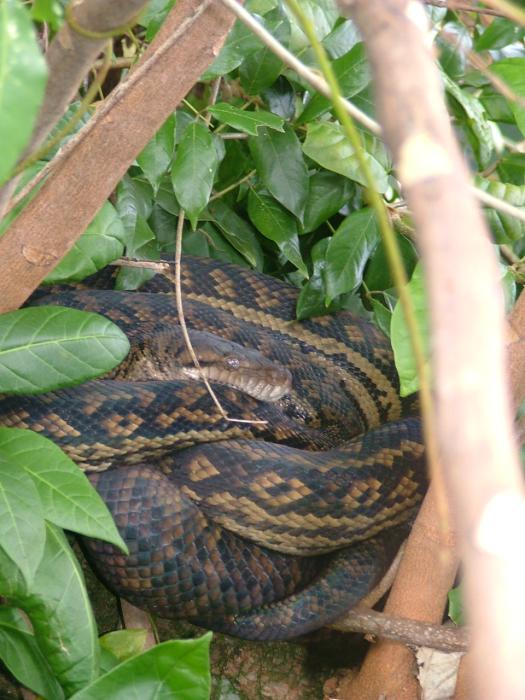
Naming is also a way to develop connections. Donald Culross Peattie, a 20th century natural historian and writer from Chicago, said this another way, talking about trees: “the easy-to-know species will soon become like the faces of your friends, known without thought, and bringing each a host of associations.” But what happens when we lose those associations or connections? Carol Kaesuk Yoon, author of Naming Nature, worries that “we are willfully… losing the ability to order and name and therefore losing a connection to and a place in the living world.” Naming and connection are interlinked, and connection is so important. It is how we learn, it is how we express joy and pleasure, and it is how we embody our values.
You've inspired me to learn more about the snakes in my backyard. You fell in love with snakes in a one-acre field near your childhood home. We are lucky that we had and have such easy access to snake habitat. For those living in an urban environment or who don't have easy access to nearby green space, how can they learn more and experience the fascinating world of snakes?
Nicolette: There are at least two ways for those of us living in urban areas to gain firsthand experiences with snakes. The first is to look for them, even in our urban areas. There are a few snake species, namely garter snakes and worm snakes, that tend to show up in urban lots. Plus, it’s a pleasure to develop a deep sense of place by simply exploring and looking closely at the world around us.
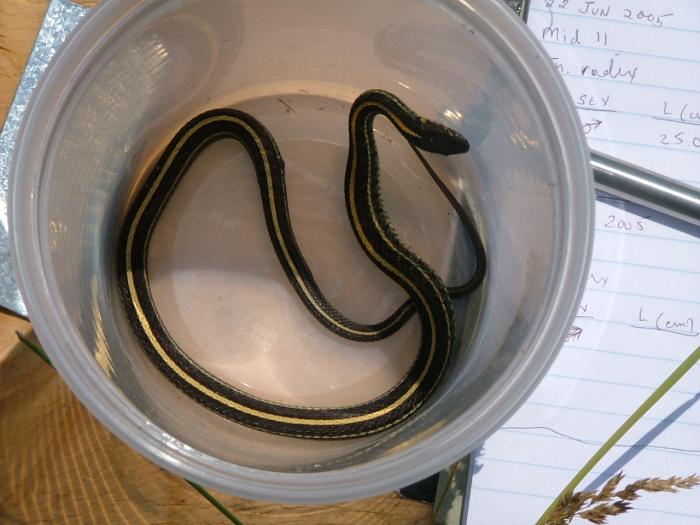
Another way to learn more about snakes is to visit a local zoo or nature center, and simply watch them. Watch the elegant way that snakes navigate their surroundings, look for the grace of their movements. Or connect to things snakes do that you do too — like drinking. Watching a snake drink, seeing the subtle movement of the muscles around the jaw and head working, is fascinating, and it's relatable too.
While I think many agree that we need to change global-level systems to be more sustainable, those changes seem huge when I'm just one person. What can I do in my own life to help snakes?
Nicolette: There are so many ways we can help snakes in our everyday lives. The first is to protect snake habitat — donate to land conservancies and snake conservation organizations. Also, avoid using herbicides and pesticides. This protects prey species like frogs and birds, so it helps snakes too. Avoid setting down any sort of mesh landscape cloth, bird netting, or glue traps. Snakes can get caught up in all of these, resulting in serious injury and death. Don’t forget to drive slowly and carefully, to avoid hitting snakes on the road. Remember, snakes have their bellies to the ground, making them extremely vulnerable. And finally, share your enthusiasm for snakes with others, especially kids. We learn from each other, and it’s important for kids to have positive associations with snakes to develop healthy conservation attitudes toward them.
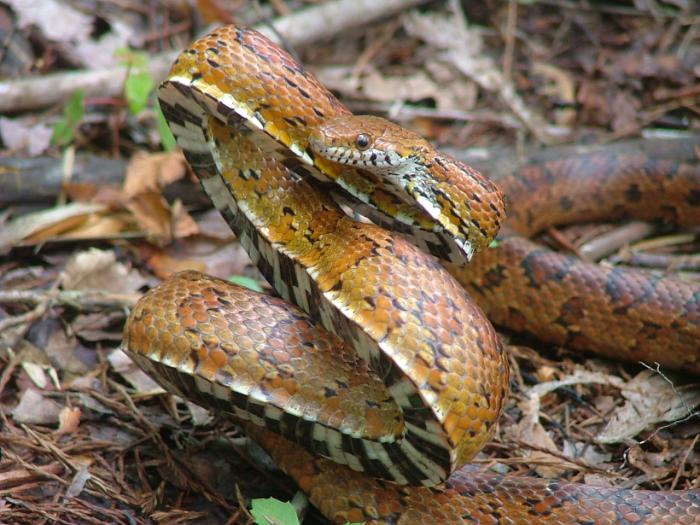
Burnout is becoming increasingly common for those of us who work in the environmental field. What keeps you moving ahead?
Nicolette: Paying attention to the little things, especially in nature, helps me stay motivated and positive. For example, seeing the big shining eyes of a black racer along a path while I’m hiking, or watching the wonder in a child’s face as I get down on my knees with a rough green snake in hand. These small moments of peace and joy can keep me going forever.
Photo by Mark Cagle.
Saving Snakes is available wherever books are sold, including Barnes and Noble, Amazon, Walmart, and UVA Press.
Want more? Read “Brake for Snakes” by Nicolette Cagle.